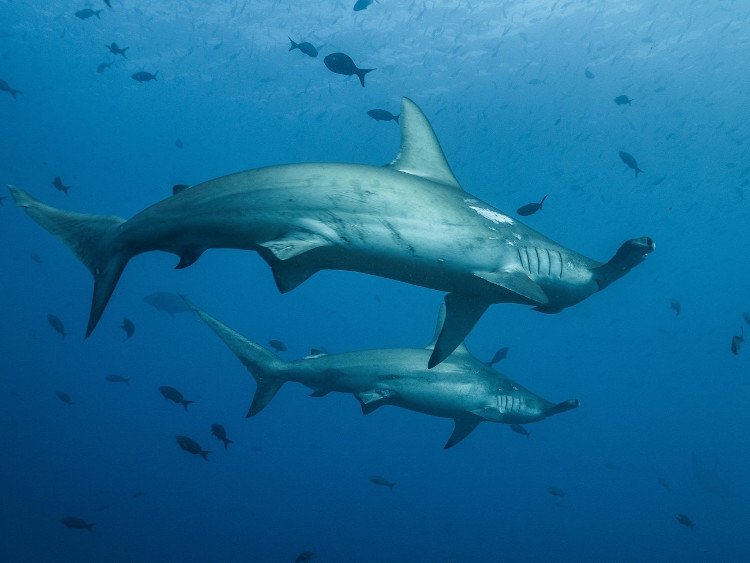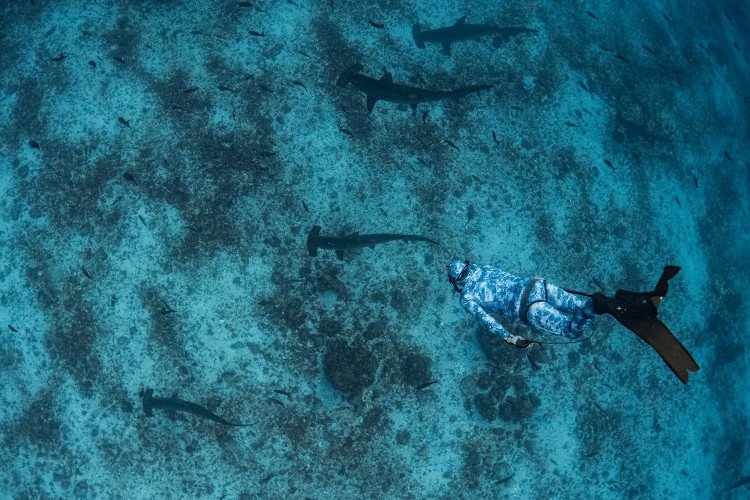For some reason, I have always had the feeling that work would take me to Galapagos one day. As a marine biologist, the natural history of the archipelago and the role it has had on our understanding of evolution has always fascinated me. As a diver, I had always heard about this part of the world as a prime shark-diving destination and one of the best places in the world to dive with big shivers of scalloped hammerhead sharks. So, landing in the Galapagos as a fresh shark researcher working for the Charles Darwin Foundation, and jumping straight away on the boat for an expedition to the Islands of Darwin and Wolf - the Mecca of hammerhead sharks in Galapagos - was just like living a dream.
Despite having a couple of decades of diving experience, getting into the water in Galapagos felt like something new. Working in the tropical islands of the Indo-Pacific for most of my career as a marine biologist, I got used to dive in warm waters, and being surrounded by colorful corals and pretty fish - easy stuff. However, jumping in the water in Galapagos felt like a new experience as everything looked and felt wilder. The cold and productive waters, that in fact make the marine ecosystems in Galapagos so special, and the bare volcanic rocks give the dive sites a rough feel, very different from the warm and pretty coral reefs I was used to. But what blew my mind was the wildlife: the animals were bigger, more abundant and more inquisitive that I had ever seen! The bottlenose dolphins were large and curious; big tunas were always coming to check us out; and bait balls could be seen from the surface in every direction we looked at on our way to the sampling sites, making an entire army of seabirds go crazy. But the sharks were an experience apart.

During this first expedition, we had three teams simultaneously collecting shark data. The team I was working with was focused on taking biopsies (or tissue samples) of hammerhead sharks. To do this, we were spending 4-6 hours per day freediving and sharing the water with blacktips, silkies and Galapagos sharks. Over the years, I’ve spent a lot of time SCUBA diving with sharks to collect data for various projects. Generally, sharks tend to ignore divers and keep their distance. But the nice thing about freediving is that we don´t blow noisy bubbles, so we can get much closer. From a sampling perspective, this means we can ´quietly´ approach the sharks from above and dive into the schools of hammerheads to collect the tissue samples, without causing major harm to the animals. Being inside a shiver of hammerheads is something magical and it´s hard to describe the feeling of sharing that space so peacefully with so many sharks. Living such experience actually makes it really hard to accept how careless we have been about protecting these magnificent animals.

Scalloped hammerhead sharks are Critically Endangered, and like many other shark species that are impacted by overfishing, they need urgent and robust conservation actions to stop populations declines. Understanding how these sharks use marine protected areas, like the Galapagos Marine Reserve, and where they go when they are outside the reserve boundaries, is essential to assess how vulnerable they are to fisheries. This information is fundamental if we are serious about designing management and conservation strategies that will give shark populations a chance to recover. Describing the movement of sharks has been an important line of research of the CDF´s Shark Ecology Project. The tracking of sharks tagged within the Galapagos Marine Reserve has shown some interesting movements such as the migration of a pregnant female hammerhead shark that went all the way to the coast of Panama (possibly to give birth) and then came back to the Galapagos region, or a silky shark tagged in Galapagos, that travelled far into the Central Pacific Ocean and back, twice. A few sharks tagged by the project have not been that lucky and ended up being fished and landed at fishing ports in the region. These examples show that beside having large marine protected areas, where sharks can be protected for part of their lives, it is essential to improve fisheries management in the region to reduce fishing mortality and to give the populations of threatened species, like hammerhead sharks, a chance to recover.
This first expedition was a full immersion into the shark project and it was also a fantastic opportunity to learn more about the ecology of sharks in Galapagos, as well as the conservation actions need to protect them. Processing and assimilating all I’ve seen and learned has been interesting and motivating. More than anything, it has reintegrating for me the need on focusing our efforts on doing science that can help improve management and conservation of shark populations in the region.







